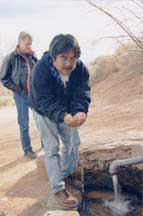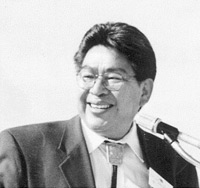Hopi Tribe Seeks to Reclaim Water From Peabody Energy
Air Date: Week of February 28, 2003
The Hopi Indian Tribe in Arizona gets eighty percent of its income selling coal, and water used to transport the coal to the Peabody Coal Corporation. But now, the water is running out and the tribal members must decide if their water is more precious than the money that they make selling it. Arizona Public Radio’s Daniel Kraker reports.
Transcript
KNOY: It's Living on Earth. I'm Laura Knoy. And coming up, another stop along the Lewis and Clark trail.
But first, for 30 years the Hopi Indian Nation in Arizona and the Peabody Energy Corporation have held a common bond in coal and water. The Hopi tribe supports itself by selling coal to Peabody and by selling water, too…water that Peabody uses to transport the coal from the mines to its processing plants. But now, ancient Hopi springs are drying up, and people on the reservation are looking for a way to end their water arrangement with Peabody without killing their economy.
Daniel Kraker of Arizona Public Radio has our story.
[SOUNDS OF PEOPLE AND BELLS]
KRAKER: On a cool autumn Sunday, a group of Hopi activists with bells tied to their ankles run more than 70 miles across the reservation. For centuries, Hopi runners have carried messages on the ancient trails linking their Mesa-top villages.
These runners also bear a message. In their hands they hold a gourd of water, a symbol of the sacred water they say is threatened.
[SOUNDS OF YELLING]
KRAKER: The runners climb into the village of Moenkopi. Onlookers thank them in the Hopi language for their sacrifice. Bucky Preston helped organize the run. His jet-black hair is cut short in front but falls long down his back, the traditional Hopi style symbolizing falling rain. Preston ran to show how important water is to him and his people.
PRESTON: I went through a lot to prepare for this run. And this is one way of telling the whole world that our land isn't for sale, and our water isn't for sale, and it's very sacred to us.
KRAKER: But Hopi water has been for sale since 1969, when the Hopi government agreed to sell it to Peabody Western Coal Company.
[VEHICLES MOVING]
KRAKER: On the reservation's northern border, the company operates five open-pit mines connected by long stretches of rudded dirt roads. Peabody pays the tribe nearly $10 million dollars a year for the coal it pulls out of Black Mesa. It pays another $3 million dollars a year for water to move the coal. That buys enough to cover a football field more than a half-mile deep. The company pumps it out of eight deep wells in the Navajo aquifer, the Hopi tribe's sole source of drinking water.
[SOUNDS OF WATER]
 Leonard Selestewa draws water from Hopi springs. Leonard Selestewa draws water from Hopi springs.(Photo: Christopher Tomlinson) KRAKER: Leonard Selestewa, president of the grassroots group Black Mesa Trust and a Moenkopi farmer, scoops water out of one of his village's two springs and lets it fall through his fingers. SELESTEWA: I grew up where I thought this water would never go away, it would always run. You know, I grew up where there was a public spring where it discharged about 35 gallons per minute. I mean, this thing was just a big pipe out of a natural source of sandstone rock, artesian well. But gradually, I saw it all diminishing. Now, the spring by the village discharges roughly seven gallons per minute. And the wash is--half the year its gone. So you've got to wonder what's causing all this. KRAKER: The high desert of northeast Arizona is a parched landscape, receiving only about 10 inches of rain a year. The springs that gushed out of the sandstone cliffs are what drew the Hopi to settle here nearly a thousand years ago. Today they get their water from wells reaching down to the aquifer, but Selestewa says the springs still play a vital religious role. SELESTEWA: Everything revolving around our religious practices, and even the more secretive ones, they revolve around sacred springs. This is said to be the channels by which the spirits of the Kachinas travel. KRAKER: From the air, Black Mesa looks like a huge hand. Hopis call it the guardian hand, because it protects the water underneath. The Hopi villages are located on the tips of the mesa fingers, stretching south from the mine. On the palm is a metal building surrounding by enormous water tanks and coal bins, the center of the controversy. [MACHINE SOUNDS] KRAKER: Inside the Black Mesa pipeline works, the noise is deafening. Coal comes in on long conveyors. Giant metal rods swung back and forth like huge hammers crush it into a fine powder. It's then mixed 50/50 with the water to form a slurry. [MACHINE SOUNDS] KRAKER: Plant manager Andy Mikesell opens a door in the pipeline to reveal a thick, black, soupy pudding. From here, the mixture is pumped 273 miles to Mohave generating station in Laughlin, Nevada, where it's dried and burned to create electricity for Las Vegas, Phoenix, and Los Angeles. This is the only coal slurry in the country. [MACHINE SOUNDS] KRAKER: Back at the mine's offices, Peabody's environmental engineering manager, Brian Dunfee, shows on a projector the company's new 3D model of the aquifer. DUNFEE: We think that's probably what this is. KRAKER: He says it shows their pumping is equivalent to taking only half a soda can out of a 55-gallon drum. Dunfee doesn't doubt less water is flowing through Hopi springs and washes, but says it isn't because of Peabody. DUNFEE: Part of what's causing that is increasing groundwater usage in the villages and in surrounding Navajo towns. Water use is increasing. Part of it, we think, is due to climatic trends. Eventually, we think things will change for the better. KRAKER: The U.S. Geological Service in Flagstaff has been collecting data on Black Mesa since the 1970s. Hydrologist Blake Thomas agrees that increased pumping in area towns has had an impact on the aquifer, but he says Peabody is also to blame. THOMAS: Well, there has definitely been pretty large declines in the water levels, upwards of 100 feet or more in some places. And those are, of course, closer to the Peabody pumping. But the declines have been a result of both Peabody pumping and municipal pumping, because municipal pumping has been growing quite a bit. So it's kind of hard to distinguish how much of the drying out is coming from either source. KRAKER: The Natural Resources Defense Council has analyzed the government's and Peabody's data and come up with a third conclusion: that the company has already damaged the aquifer. NRDC attorney Andrew Wetzler says the issue has been studied to death and it's time to act. WETZLER: Yes. You don't need to have a Ph.D. in hydrology to know that withdrawing a billion gallons of water in a desert climate from the sole source of drinking water for a community is an extraordinarily bad idea. And I think that almost everybody agrees to that now. KRAKER: For the Hopi, the reality is their springs have been disappearing for a decade. And that leaves them an impossible choice between their income and their water. And they've chosen water. Hopi chairman Wayne Taylor has told Peabody it will have to leave when its lease expires in 2005 unless it can find an alternate source of water. The Hopi's argument is simple: without water, there's no life.
|

 Wayne Taylor, Jr., Chairman of the Hopi Tribe, Arizona
TAYLOR: Well, of course, we come from the standpoint, which everybody will agree with, that water is our lifeblood. It's just unconscionable for anyone to be using pristine water such as we have here for industrial use.
Wayne Taylor, Jr., Chairman of the Hopi Tribe, Arizona
TAYLOR: Well, of course, we come from the standpoint, which everybody will agree with, that water is our lifeblood. It's just unconscionable for anyone to be using pristine water such as we have here for industrial use.




